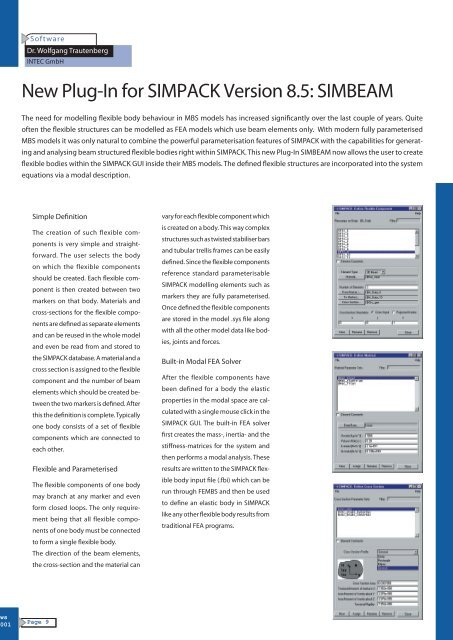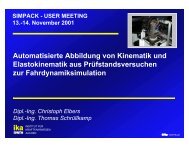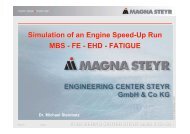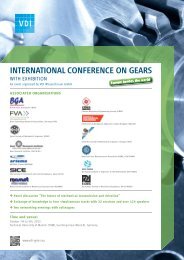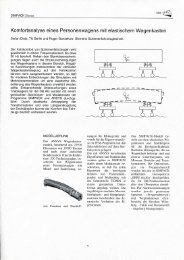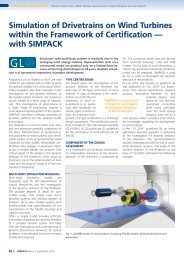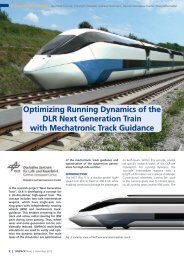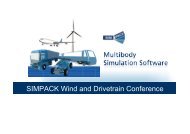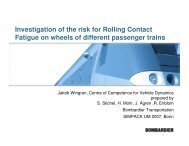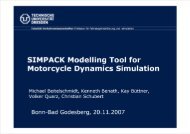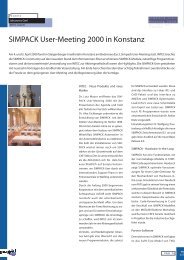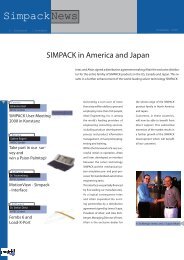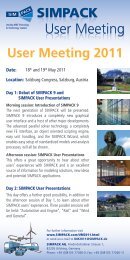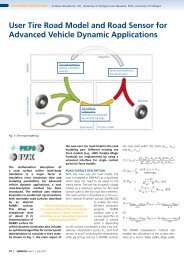SIMPACKNews
SIMPACKNews
SIMPACKNews
Create successful ePaper yourself
Turn your PDF publications into a flip-book with our unique Google optimized e-Paper software.
ws<br />
001<br />
ews<br />
00s<br />
Software<br />
Dr. Wolfgang Trautenberg<br />
INTEC GmbH<br />
New Plug-In for SIMPACK Version 8.5: SIMBEAM<br />
The need for modelling flexible body behaviour in MBS models has increased significantly over the last couple of years. Quite<br />
often the flexible structures can be modelled as FEA models which use beam elements only. With modern fully parameterised<br />
MBS models it was only natural to combine the powerful parameterisation features of SIMPACK with the capabilities for generating<br />
and analysing beam structured flexible bodies right within SIMPACK. This new Plug-In SIMBEAM now allows the user to create<br />
flexible bodies within the SIMPACK GUI inside their MBS models. The defined flexible structures are incorporated into the system<br />
equations via a modal description.<br />
Simple Definition<br />
The creation of such flexible components<br />
is very simple and straightforward.<br />
The user selects the body<br />
on which the flexible compo nents<br />
should be created. Each flexible component<br />
is then created between two<br />
markers on that body. Materials and<br />
cross-sections for the flexible components<br />
are defined as separate elements<br />
and can be reused in the whole model<br />
and even be read from and stored to<br />
the SIMPACK database. A material and a<br />
cross section is assigned to the flexible<br />
component and the number of beam<br />
elements which should be created between<br />
the two markers is defined. After<br />
this the definition is complete. Typically<br />
one body consists of a set of flexible<br />
components which are connected to<br />
each other.<br />
Flexible and Parameterised<br />
The flexible components of one body<br />
may branch at any marker and even<br />
form closed loops. The only requirement<br />
being that all flexible components<br />
of one body must be connected<br />
to form a single flexible body.<br />
The direction of the beam elements,<br />
the cross-section and the material can<br />
Page 9<br />
vary for each flexible component which<br />
is created on a body. This way complex<br />
structures such as twisted stabiliser bars<br />
and tubular trellis frames can be easily<br />
defined. Since the flexible components<br />
reference stan dard parameterisable<br />
SIMPACK mo del ling elements such as<br />
markers they are fully parameterised.<br />
Once defined the flexible components<br />
are stored in the model .sys file along<br />
with all the other model data like bodies,<br />
joints and forces.<br />
Built-in Modal FEA Solver<br />
After the flexible components have<br />
been defined for a body the elastic<br />
properties in the modal space are calculated<br />
with a single mouse click in the<br />
SIMPACK GUI. The built-in FEA solver<br />
first creates the mass-, inertia- and the<br />
stiffness-matrices for the system and<br />
then performs a modal analysis. These<br />
results are written to the SIMPACK flexible<br />
body input file (.fbi) which can be<br />
run through FEMBS and then be used<br />
to define an elastic body in SIMPACK<br />
like any other flexible body results from<br />
traditional FEA programs.


